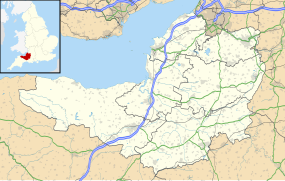Pagans Hill Roman Temple

A reconstruction drawing of Pagans Hill Roman Temple
|
|
|
Map showing the location of Pagans Hill Roman Temple in Somerset.
|
|
| Location | Chew Stoke, Somerset. |
|---|---|
| Region | South-West |
| Coordinates | 51°21′39″N 2°38′14″W / 51.360732°N 2.6373580°W |
| Type | Romano-Celtic Temple |
| History | |
| Founded | 3rd Century AD |
| Abandoned | 4th Century AD |
| Cultures | Roman |
| Management | English Heritage |
The Pagans Hill Roman Temple was a Romano-British-style temple (Romano-Celtic temple) excavated on Pagans Hill at Chew Stoke in the English county of Somerset.
The temple was on a promontory overlooking the River Chew. It was excavated by Philip Rahtz between 1949 and 1953. In addition to the foundations of the temple a well (17 metres deep) and several ditches were found which contained small artifacts showing occupation of the site before the Roman period including pottery of Iron Age type, and a coin dating from c335-7. Evidence of continuing use after the Roman period is provided by a bucket and an exotic 7th century glass jar found in the well.
It was originally thought, on its discovery in 1830, to have been a beacon, for signalling between adjoining hill forts.
It was a double-octagonal temple building comprised an inner wall, which formed the cella or sanctuary, surrounded by an outer wall forming an ambulatory, or covered walkway. The outer portico measures about 56½ feet in diameter, the inner cellar about 32 feet across. All walls were about 3 feet thick. Along each wall were two features described by Rahtz as buttresses but were more likely to have been pilasters, as their small size would render them ineffective as wall supports. Warwick Rodwell suggests that the ambulatory would have been cross-vaulted and the pilasters used as external supports for this. This would allow for a good deal of natural light to circulate the building and give an aesthetically balanced look to the structure. The ambulatory would then give the illusion of a labyrinth of side chambers running off from the central area.
...
Wikipedia

